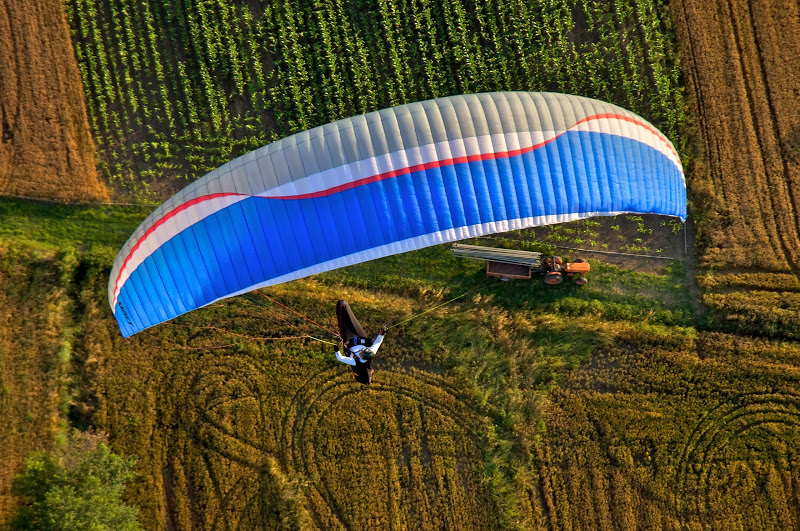AIRDESIGN GmbH.
Rhombergstraße 9, 3. Stock
A-6067 Absam
Innsbruck
Austria
UID Nr. ATU66352608
Phone us: +43 (0) 5223 22480
Email us: info@ad-gliders.com
Hong Kong Distributor: Kenneth, +852 9203 1889, ama8801@yahoo.com.hk

How do AirDesign test prototypes?
At AirDesign we don’t just test the ‘official’ manoeuvres during development. We also test more practical issues, such as what happens if a pilot reacts in the wrong way in-flight or during a manoeuvre and also what we think pilots themselves might try to do ‘just to see what happens’? For example, we test what happens if a glider is stalled during a collapse? Or how high wingovers can be before the glider collapses? Is the glider stable in turbulence? Is it possible to make acro manoeuvres? How far does a glider dive in front if released wrongly after a stall? They are not the most comfortable things to do, but we believe that this is a big part of how we make a glider work for the pilots who are going to buy it and fly it. In each certification category our wings have to fulfill far more than what is required by the standard certification tests, before we consider them ready to be certified.
The practical flying and real-air testing is the most time-consuming test period during the development of a wing. We need to know and understand the flying characteristics of the wing in moving air. Is the glider stable, neutral, pitching, performing well, climbing well, turning efficiently …? We spend a lot of time collecting input while flying in different conditions, clipping-in at varying weights, using different harness and generally flying as much as possible in all conditions. Our headquarters in the Austrian Alps allow us access to some of the most challenging and varied real-life conditions anywhere. From the first prototypes VOLT performed very well and the ‘usual’ practical niggles were not an issue. We started to feel that with this wing we have something special. As testing and trimming continued, VOLT became everyone’s favorite glider to fly outside work hours, so much so that we had to lock it away so that it was available for the official certification tests! Development and testing have been a real pleasure for us. Test fly VOLT and let us know what you think.

Certification of mini wings
Although the Susi 18 and 20 sizes are certified we don't believe that this certification category is equivalent to that of a standard-sized wing. The 18 and 20 are fulfilling the LFT/EN norm but these certification standards were not formulated to deal with 'special' cases. Mini wings are special, with high internal pressure and higher dynamics than standard sized paragliders. During the certification processes certain manoeuvres are tested and the resulting recovery ranked, but not the gliders characteristics or the pilots profile .
We used folding lines (collapse lines) to certify these sizes. Folding lines are attached in front of the standard A-line connection tabs. Making collapses with the normal line configuration is very difficult due to the extremely high collapse resistance of mini wings. The folding lines are used to get a collapse to the required angle of collapse which is defined by the norm. Collapses induced with folding lines do not necessarily reflect the same behaviour that the glider will show in normal flight. |

How did we design and test VITA?
VITA started life as a small seed of inspiration when AirDesign designer & test pilot, Stephan Stiegler saw how beginner and novice pilots were always looking enviously at the wings of the competition pilots in his home valley.
Why did entry level gliders have to be built like parachutes without the details that gave the 'Performance Class' their finesse?
After a few proto-types and many hours of testing new riser geometry, altering the type and lengths of leading edge stiffening and then flight tests, the VITA was 'born' and brought a new standard of features to the class.
At AirDesign we don’t just test the ‘official’ manoeuvres during development. We also test more practical issues, such as what happens if a pilot reacts in the wrong way in-flight or during a manoeuvre and also what we think pilots themselves might try to do ‘just to see what happens’?
For example, we test what happens if a glider is stalled during a collapse? Or how high wingovers can be before the glider collapses? Is the glider stable in turbulence? Is it possible to make acro manoeuvres? How far does a glider dive in front if released wrongly after a stall?
They are not the most comfortable things to do, but we believe that this is a big part of how we make a glider work for the pilots who are going to buy it and fly it.
In each certification category our wings have to fulfil far more than what is required by the standard certification tests, before we consider them ready to be certified.
The practical flying and real-air testing is the most time-consuming test period during the development of a wing.
We need to know and understand the flying characteristics of the wing in moving air so we spend a lot of time collecting input while flying in different conditions, clipping-in at varying weights, using different harness’ and generally flying as much as possible in all conditions.
Fortunately our headquarters in the Austrian Alps allow us access to some of the most challenging and varied real-life conditions anywhere.
SuSi - Our philosophy
Test flights have proven that SuSi has good pitch stability with easy handling for a wing of this type.
With only a little brake input, SuSi can be flown like a standard glider, turning flat and with an astounding climb for its small size. With more pilot input SuSi is super agile, super fun and can be turned like a speed glider. SuSi responds to brake input and quickly builds momentum to make radical wing-overs or hook-turns absolutely thrilling!
For a wing of this type SuSi has a good glide, (around 7 to 8) making it comparable with many extra small intermediate paragliders. SuSi cuts through turbulence without excessive reaction, absorbing the bumps with minimal pitch or roll. The handling, whilst still active, has been reduced to manageable levels making SuSi one of the most comfortable gliders of this type.
•The airfoil of SuSi was developed especially for this type of wing with technology developed directly for our 2-line race gliders.
•A new line-layout with rear positioned attachment point’s results in relatively neutral flying characteristics and reduction in total line consumption.
•3-line concept with split D at the upper C-lines.
•Polyamide rods in the leading edge keep the profile in perfect shape and improve performance and launch characteristics.
•3D Cut: a technical sail cutting method used across the leading edge area. This produces an improved air flow and increased performance.
•Performance style reinforced 12mm risers, adjustable brake handles and dirt-holes at the wing tips complete the quality finish.
The collaboration with Peter Habeler began as the famed Everest mountaineer met the AirDesign team on the ski slopes of his Mayrhofen home. Peter was intrigued by the Speedriding wing FOX and quizzed the team at length about the development of a sport which combines skiing with flying.
A later encounter as the team were testing a prototype SuSi sparked his interest and rekindled his dreams of a fast, comfortable descent from the Alpine peaks of his homeland. Peter has followed the SuSi project throughout development and is delighted to put his name to a paraglider that meets his ideal; lightweight equipment for mountain adventures.
For those who crave minimalism, SuSi SuperLight 'Peter Habeler' edition is delivered with lightweight risers and additional Dyneema line links to replace the standard maillons.
The standard colour 'Tibet', is a tribute to Peter's affinity for the Himalayan ranges. |
























